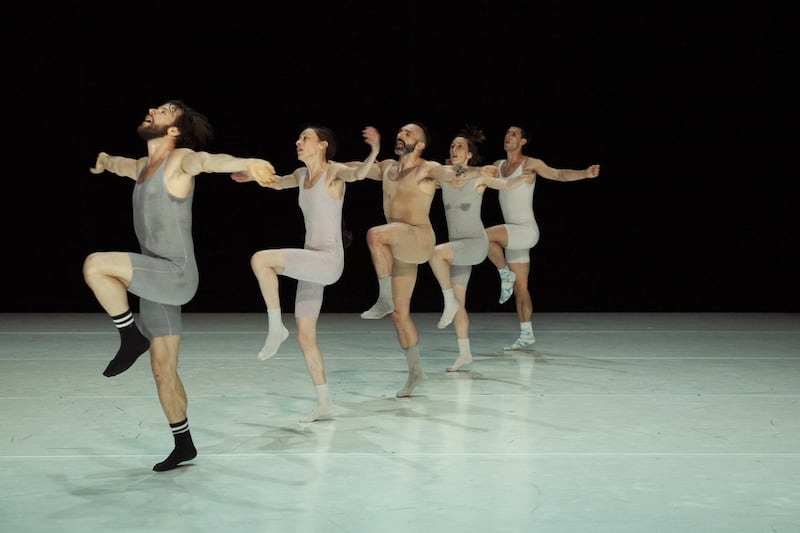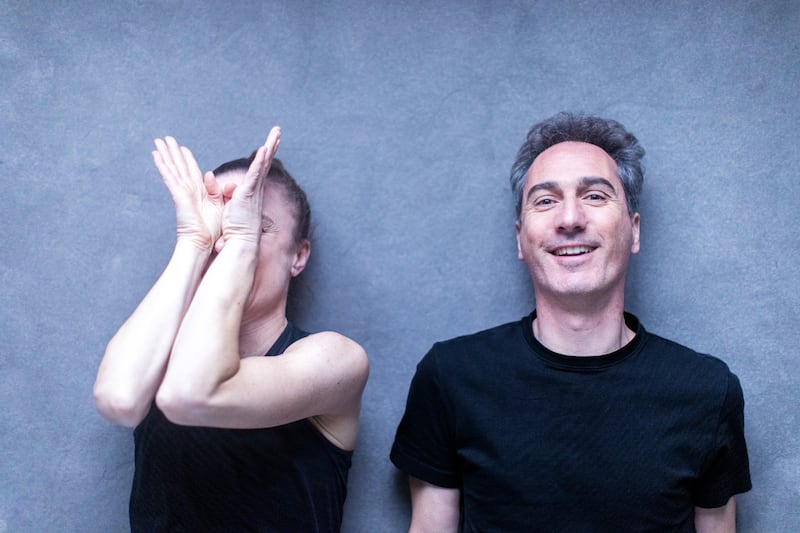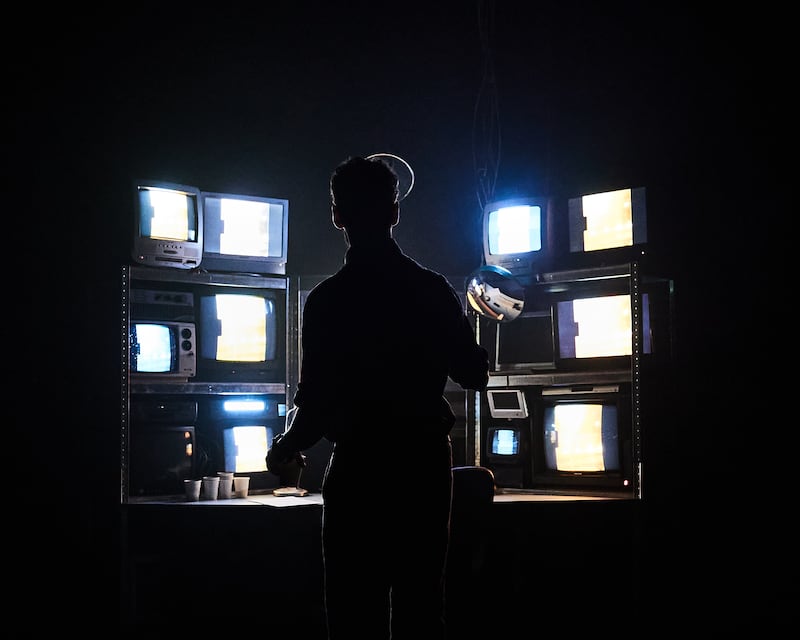Let Go. Take Heart. Begin Again. Under that slogan, reconnection emerged as a theme during the first week of this year’s Dublin Dance Festival. All of the featured works were made during or after hitting the brick wall of Covid restrictions and reflected that period of time. Dance, possibly more than any other art form, was affected by how deeply society had to limit touch, breath and groups of people, all well-worn tools in the choreographer’s toolbox.
So was there a common response to those restrictions?
It is foolhardy (but so tempting) to pose the question based on the minuscule sample size of one week of this festival. But two themes emerged from the curatorial choices of its artistic director, Jazmin Chiodi.
Dancers were seen advocating our basic connection to other humans and our world, a quiet affirmation that is more urgent in these days of far-right protests and climate denialism. Another theme was physical struggle, as some works showed physicality pushed to extremes, with dancers forced to physical exertion, but without becoming overwhelmed. Underpinning both these themes was a palpable artistic confidence, whichever style any choreographer was working within. We are who we are and are not afraid to say it.
READ MORE
For pure sweat and visceral thrill, The Pretty Things (★★★★☆) by Compagnie Catherine Gaudet was a highlight. For nearly an hour, tiny twitches progressively developed into physical freakout, as four dancers (one fewer than usual because of illness) relentlessly unwound a tour de force of perpetual motion.

Beginning far apart with individual repeated movements, they coalesced into a group, eventually becoming a straight line of cancan-like kicking that slowly spun around. All the time they were driven by musical impulses. Beginning as gentle pulsing vocalisations, Antoine Berthiaume’s score crescendoed to Philip Glass-like looping arpeggios.
The unison movement might unite the dancers with a common sense of purpose, but the music seemed to corral them into obedience. Close to being overpowered, the dancers broke out of the unison straitjacket into solos. While physical relentlessness is the single unifying factor in The Pretty Things, effort alone didn’t earn its standing ovation. Along the way it also addressed issues of imposed order versus individuality and of human connection in the face of adversity.
The physical being pushed to the maximum was also found in Magdalena Hylak’s A Dance (★★★☆☆), one of three works in the Originate performance showcase, which features emerging choreographers and works in development.

In the daylit Joanna Banks Studio at DanceHouse, Hylak developed improvised looping movement phrases, simple arm movements growing into relentless, Sufi-like spinning. All the time she became more enveloped by an increasingly loud soundscore by Lionel Kasparian that in the end failed to overpower the lone dancer.
Jessie Thompson pursued similar relentlessness in Crawler (★★★☆☆) to live music by Jason McNamara. Using a hip-hop-inflected vocabulary, Thompson pushed herself to physical extremes but driven by an internal impulse. Here the music followed and matched the movement but ultimately diluted both.
Although still a work in progress, Impasse (★★★★☆) by Mufutau Yusuf was almost perfectly formed, as it eloquently challenged bodily identity and autonomy, in this case the black body. Along with his fellow dancer Tomas Ntamashimikiro, Yusuf’s quiet spoken choreography was anti-rhetorical in its use of simple gestures, glances and dance phrases. Already a successful dancer (he features in two other live performances and one film during the festival), Yusuf is emerging as a promisingly clear-visioned choreographer.
Instead of opening-night fireworks, this year’s festival had a quiet inception, with Trajal Harrell’s beautifully realised The Köln Concert (★★★★★) performed by Schauspielhaus Zürich Dance Ensemble. Like The Pretty Things, it began with individuals who coalesced into a community, but with the quiet rhetoric of Joni Mitchell and Keith Jarrett’s famous concert in Cologne. With a bedrock of vogueing, a stylised dance form that came to prominence in the black and Latino LGBTQ community in Harlem in the 1980s, Harrell interwove other influences, including butoh and postmodern dance, into a wonderfully understated celebration of humanity that placed the body at the crux of both difference and community.
The Archivist (★★★★☆) is the first instalment of a seven-part Prometheus Project by Dublin Dance Festival’s new artist-in-residence, Luke Murphy. He created his hugely successful, award-laden Volcano during lockdown, and The Archivist was similarly dark, if not as creepy.
Murphy played an archivist, alone (with the audience) in a small windowless office that was complete with retro technology and an oppressively dull, beige atmosphere. Within this analogue world a dot-matrix printer produced paper memories that he stamped, punched, stapled and filed.
But the end, called the blackout, was fast approaching, and the archivist was waiting to hear if he would survive.
As the clock ticked down the final minutes, and as he ignored phone calls from his estranged family trying to reconnect, his loyalty to his tasks finally snapped.
What was the use for these needless facts that he gathered and filed? And, by extension, how do we value human connection compared with bulging data centres’ worth of random facts. The Archivist was an impressive beginning to the series, with its combination of narrative, immersive installation and use of movement as emotion, saying what words can’t express.

By contrast, Liz Roche’s installation Kindred (★★★☆☆) offers a more spacious and smoothly digital experience. Eight screens of various sizes are set in the sunken garden court of the new ESB headquarters on Fitzwilliam Street in Dublin and viewed from above. Created in collaboration with Lightscape, it is a call to reconnect with nature as part of building a sustainable future, connections that will be fleshed out in a round-table talk on Tuesday.
Rather than dwelling on current failures, Roche simply highlights connections between the human and natural world. Emily Ní Bhroin’s costumes have bold green and brown swishes roughly tracing spines and bones, while images show veins and capillaries that connect blood cells, just as plant cells are connected. Touch is also important. The dancers on screen reach out arms to connect hands and support leaning bodies.
Roche’s Yes and Yes (★★★★☆) made a return to Project Arts Centre after enjoying success in the United States. A delve into episodes from Joyce’s Ulysses, with what seemed to be some updated background graphics, it remains a multilayered, warm-hearted and at times funny exploration of the rich imagery and senses in the text.
Dance for young audiences has always been a part of the festival, which this year featured Marc Brew’s The Race (★★★★☆), a welcome commission for children aged four and older from the Ark, Dublin Dance Festival and Arts & Disability Ireland. Mashing up three of Aesop’s fables, the cast of disabled and nondisabled dancers introduced the Tortoise, Hare, Grasshopper, Ants, Mouse and Lion with full participation from the audience. Simple, inclusive and thoroughly entertaining, it ticked all the boxes for a successful children’s show.











